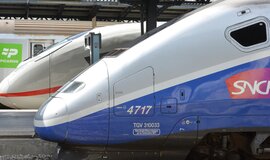
Together for the future of the railways –
DB and SNCF extend their digital cooperation
For the last four years, Deutsche Bahn (DB) and SNCF (France’s rail) have been working together to digitalise their rail systems. At this year's Digital Summit, they presented their joint projects, goals and vision, and signed a new agreement for three more years of cooperation. The technology portfolio of Digitale Schiene Deutschland (DSD) forms a central part of this cooperation.
On 25 February, the annual summit of the cooperation between DB and SNCF took place. It was attended by over 60 participants, including Jean-Pierre Farandou (SNCF President), Dr Richard Lutz (CEO of Deutsche Bahn), Pierre Izard (SNCF Director of Technology and Innovation) and Prof Dr Sabina Jeschke (DB Board Member for Digitalisation and Technology). Due to the current pandemic, this year's summit was held virtually via video conference. However, this didn’t detract from the exciting presentations on the partnership’s goals and results, as well as discussions and appreciation of the key themes. The summit ended with the signing of the new cooperation agreement. The agreement focuses on seven areas through which the automation of rail operations is to be driven forward, and the quality, performance and appeal of rail transport are to be increased. Five of these focus on key elements of the Digitale Schiene Deutschland technology portfolio.
The summit began with a presentation about the cooperation’s joint work on a holistic system architecture which combines various initiatives of new architectures (see RCA, OCORA) within the framework of the European rail initiative Shift2Rail. In the future, it is to be taken up in the System Pillar of the new Shift2Rail programme. The cooperation demonstrates that a coordinated and united approach by EU partners is often the driving force behind European programmes – and essential for the creation of a universal technical architecture in the railway sector.
The joint achievements of the teams in the field of automated train operation were also presented. Here, the main focus was on the degrees of automation (GoA): GoA2 and GoA4, and the advancement of obstacle detection in automated driving.
Certainly, DB and SNCF don’t just work together bilaterally. They also work with other partners to develop solutions for the fail-safe localisation of trains. One such project is ‘CLUG’ (Certifiable Localization Unit with GNSS in the railway environment), supported by both the Agency for European GNSS (the global navigation satellite system) and other European railway and industry partners.
Furthermore, Connectivity is an important future topic for the cooperation. The challenge is to replace GSM-R (the current railway mobile communications standard) with FRMCS/5G data communication. This is an important foundation for further rail digitalisation, so that data from sensors and cameras on tracks and trains can be collected, processed, analysed and made available to the artificial intelligence- (AI) based traffic management in real time.
The topic of Artificial intelligence (AI) in traffic and incident management concluded the presentations. The aim here is to expand capacity, raise efficiency potential and improve service quality.
By strengthening the cooperation in the area of research and development, the two railway organisations are reaffirming their vision and goal of jointly setting new standards and thus accelerating the European railway sector's path into the future.